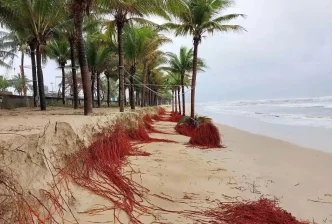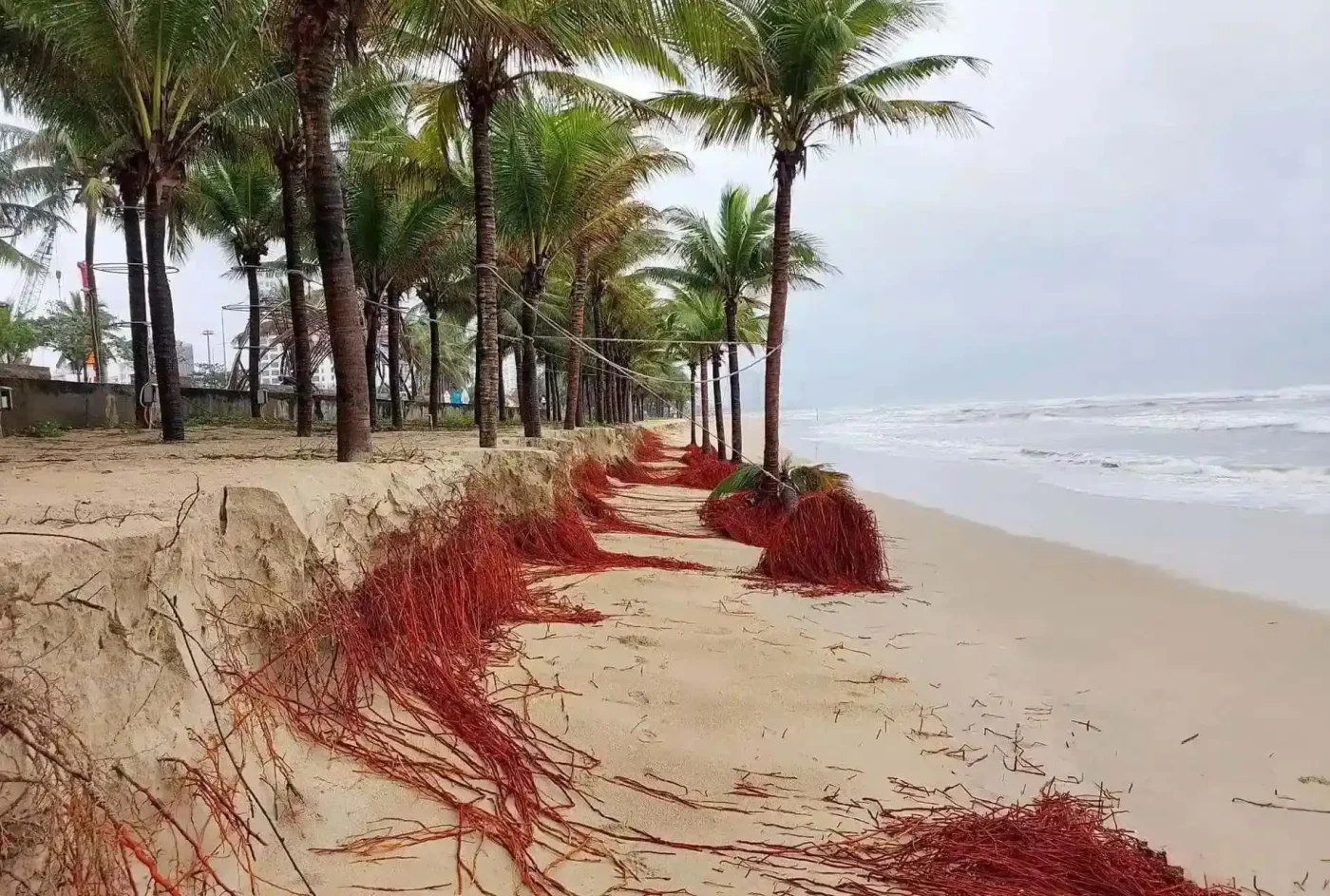Erosion has struck a significant blow to Vietnam’s cherished coastal landscapes, with a 100-metre section of sea dike on My Khe Beach in Da Nang succumbing to relentless waves and heavy rains. This environmental challenge not only endangers local tourism and trade but also highlights the broader vulnerabilities facing Vietnam’s extensive coastline amid climate change and urban development.
The damage, which has forced traders to relocate and raised alarms among residents, underscores the economic stakes for a region reliant on beach-based attractions. If left unaddressed, experts warn, such erosion could erode not just sand and structures but also the livelihoods of thousands in the tourism sector.
The Immediate Crisis on My Khe Beach
In recent weeks, uninterrupted rainfall and surging sea waves have eroded up to 20 metres of dike and walkways on My Khe Beach, located on the Son Tra peninsula. This pristine stretch, known for its white sands and vibrant entertainment spots, has seen concrete foundations exposed, prompting urgent reinforcements with sandbags and bamboo piles. Local authorities in Da Nang have initiated an emergency plan to stabilise the area, but the scale of the damage has left traders scrambling to protect their businesses.
Erosion is not isolated to My Khe. Just 3 kilometres away, Man Thai Beach has also shown signs of wear, while Cua Dai Beach in neighbouring Hoi An has lost 200 metres of shoreline over the past few weeks. In response, the central province of Quang Nam has declared an emergency, mobilising rapid response teams to mitigate further losses. These incidents reflect a pattern of coastal degradation that has intensified in recent years, with high waves between October and December exacerbating the problem.
The economic repercussions are immediate and tangible. My Khe Beach, a cornerstone of Da Nang’s tourism industry, attracts millions of visitors annually, contributing significantly to the city’s GDP. Local bar owners and vendors, who depend on the beach for their income, have reported moving operations inland to avoid risks. If the erosion continues unchecked, it could lead to cancellations of bookings and a downturn in visitor numbers, potentially costing the regional economy millions in lost revenue.
Historical Context and Human Factors
Vietnam’s 90-kilometre coastline in Da Nang is part of a larger network of 11 public beaches, many of which have historical significance. Older fishermen in coastal villages on the Son Tra Peninsula recall how a vast forest of casuarina trees, planted since the 1960s, once acted as a natural barrier against erosion. However, rapid urbanisation and the proliferation of beach hotels and resorts have gradually diminished this “green dike,” replacing natural defences with concrete structures that are now proving inadequate.
Additionally, fishermen have noted the loss of protective coral reefs along the coastline, damaged in the 1980s due to a combination of environmental pressures and human activities. This historical erosion, documented over decades, points to a mix of natural and anthropogenic causes. At a recent scientific conference, experts from the International Union for Conservation of Nature (IUCN) attributed the accelerated degradation in Quang Nam and Da Nang to rising sea levels, poor management of the Vu Gia-Thu Bon river system, and unchecked urban expansion.
While these factors are well-established, the current crisis raises questions about the effectiveness of existing coastal management strategies. If reforms in river system oversight and urban planning are implemented, they may help reduce future erosion; however, no evidence currently confirms that such measures would fully mitigate the risks, and estimates of their impact remain unverified.
Broader Economic Implications and Expert Analysis
The erosion events in Da Nang and Hoi An are more than local nuisances; they represent a potential economic threat to Vietnam’s tourism-dependent economy. Tourism accounts for a substantial portion of the country’s GDP, with coastal areas like Da Nang serving as key draws for international visitors. High-profile beaches such as My Khe have been marketed as eco-friendly destinations, but the recent damage could undermine this image, leading to long-term declines in foreign investment and job opportunities.
Experts from the IUCN have warned that without intervention, beaches like Cua Dai could face irreversible loss. Rising sea levels, linked to global climate change, are a primary driver, compounded by local issues such as river management. Poor oversight of the Vu Gia-Thu Bon system, for instance, may exacerbate erosion by altering sediment flows; if confirmed through further studies, this could necessitate policy changes. Yet, as with all speculative claims, no definitive evidence links specific management failures to the current events, and adverse inferences should be avoided.
In a conditional analysis, if erosion continues at the current rate, it may result in the loss of up to 10% of Da Nang’s tourism revenue in the coming year, based on preliminary models from environmental groups. However, these estimates are unconfirmed and should be treated with caution, as they rely on assumptions about weather patterns and government responses. Vietnam’s government has pledged to address such vulnerabilities through national climate strategies, but the success of these efforts remains to be seen.
Community Perspectives and Potential Solutions
Residents and stakeholders offer varied insights into the crisis. Fishermen in Son Tra villages emphasise the need to restore natural barriers, advocating for reforestation and coral reef rehabilitation. Meanwhile, local tourism operators call for immediate engineering solutions, such as enhanced dikes and seawalls, to protect their investments. This diversity of views highlights the challenge of balancing economic development with environmental sustainability.
On a positive note, initiatives like the bamboo walls erected at Cua Dai Beach demonstrate adaptive measures that could be scaled up. These low-cost interventions, combined with community education on climate resilience, may offer a pathway forward. If proven effective through monitoring, such approaches could serve as models for other vulnerable coastal areas in Southeast Asia.
Looking Ahead: The Need for Coordinated Action
As Vietnam grapples with these environmental challenges, the economic toll could extend beyond immediate losses, potentially affecting related sectors like hospitality and transport. Da Nang’s city authorities are working with national agencies to develop a comprehensive protection plan, but the outcome depends on timely funding and international cooperation. In the absence of swift action, the worry among residents is that iconic beaches might soon disappear, eroding not just the landscape but also cultural heritage.
This story serves as a stark reminder of the interconnectedness of environmental health and economic stability. While the full extent of the damage is still unfolding, proactive measures—grounded in verified data—could help safeguard Vietnam’s coastal treasures for future generations.













